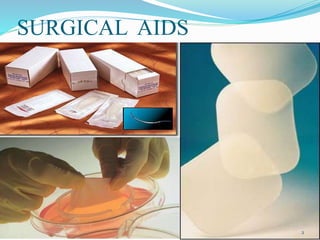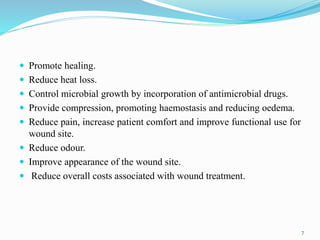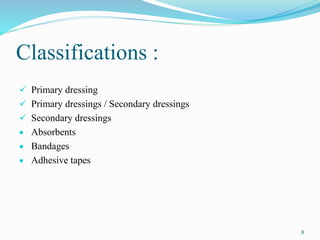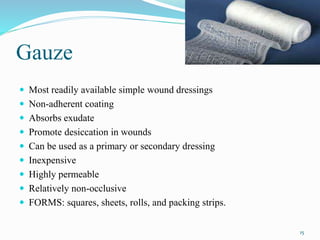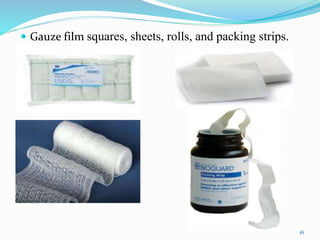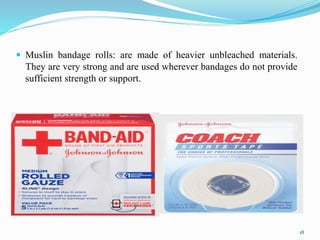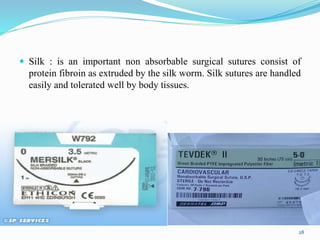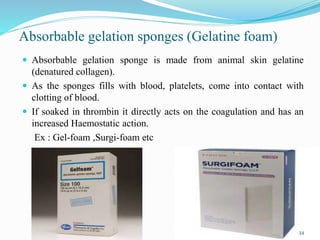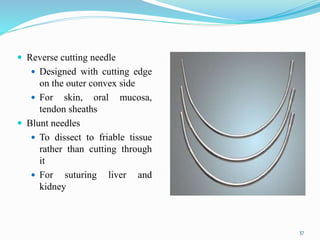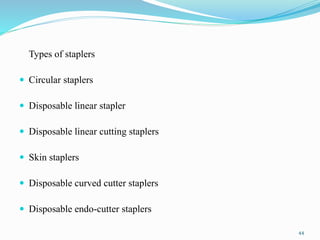Surgical aids
- 1. Presented by: Vrushali V. Sonawadekar M-pharm 2nd year Dept. of pharmaceutics KLE’U college of pharmacy 1
- 3. Contents Introduction Surgical dressings Sutures & ligatures Absorbable gelation sponges Medicated bandages Catguts- Absorbable & Non-Absorbable Surgical equipment conclusion References 3
- 4. Introduction Surgical aids : These are materials used for dressing of wounds or injured or diseased tissues to hold wound edges closely during healing ,these materials are collectively called surgical aids. Historically, a dressing was usually a piece of material, sometimes cloth, but the use of dung, leaves and honey have also been described. Previously, the accepted wisdom was that to prevent infection of a wound, the wound should be kept as dry as possible. 1860, English surgeon, Joseph Lister, began treating his surgical gauze with carbolic acid, known today as phenol, and subsequently dropped his surgical team's mortality rate by 45%. 1870, Robert Wood Johnson, co-founder of “Johnson & Johnson”, began producing gauze and wound dressings treated with iodine. 4
- 5. Modern wound dressings 1990, the surgical dressings expanded into the well-recognized groups of products, such as vapour-permeable adhesive films, hydrogels, hydrocolloids, alginates, and synthetic foam dressings. Additionally, new groups of products, such as anti-adhesive, mostly silicone meshes; tissue adhesives; barrier films; and silver- or collagen-containing dressings, were introduced. Finally, combination products and engineered skin substitutes were developed. 5
- 6. Surgical dressings : Def : Surgical dressing is a term applied to a wide range of materials used for dressing wounds or diseased tissues. Ideal wound dressings : Provide an environment for moist wound healing. Prevent maceration by permitting evaporation or absorption. Promote haemostasis (i.e. stops bleeding) Protect the wound from further damage e.g. mechanical damage, microbial invasion, dehydration, maceration,chemical damage, alteration in pH. 6
- 7. Promote healing. Reduce heat loss. Control microbial growth by incorporation of antimicrobial drugs. Provide compression, promoting haemostasis and reducing oedema. Reduce pain, increase patient comfort and improve functional use for wound site. Reduce odour. Improve appearance of the wound site. Reduce overall costs associated with wound treatment. 7
- 8. Classifications : Primary dressing Primary dressings / Secondary dressings Secondary dressings Absorbents Bandages Adhesive tapes 8
- 9. Primary Dressing: A dressing that touches the wound site. Ex : Plain gauze , Impregnated Gauze , Paraffin gauze dressing etc Secondary Dressing (Bandage): Keeps the primary dressing in site Ex : Absorbents , Bandages , Adhesive tapes etc Some dressings function as primary dressing only. However some could function both as primary as well as secondary dressing Ex : Composite dressings , Hydrogel etc 9
- 10. Primary wound dressings Plain gauze Impregnated Gauze Paraffin gauze dressings Film dressing 10
- 11. Primary / Secondary wound dressings Composite dressings. Ex: absorbent rayon or cotton pads sandwiched btw porous Polyethylene films. Hydrogel : Hydrogels are available as sheet dressings or gels. Brands: Tegagel®, Intrasite® 11
- 12. Sheet form Gel form 12
- 13. Hydrocolloids Hydrocolloids slowly absorb fluids, leading to a change in the physical state of the dressing & the formation of gel covering the wound Provide moist wound environment Provide PAIN RELIEF by covering nerve endings with both gel and exudate. Constituents are methylcellulose, pectin, gelatine, and poly-isobutylene. Hydrocolloids are used both acute wounds and chronic wounds and for different stages of light-to-heavy wounds Brand: DueDERM® 13
- 14. Secondary wound dressings Absorbents Surgical cotton Surgical gauzes 14
- 15. Gauze Most readily available simple wound dressings Non-adherent coating Absorbs exudate Promote desiccation in wounds Can be used as a primary or secondary dressing Inexpensive Highly permeable Relatively non-occlusive FORMS: squares, sheets, rolls, and packing strips. 15
- 16. Gauze film squares, sheets, rolls, and packing strips. 16
- 17. Bandages (Medicated bandages) Bandages : are use to hold dressing in place by providing pressure or supports. Bandages may be extensive or non extensive ,adhesive or non adhesive ,flat or tubular or become rigid after shapping for immobilization. Types of bandages : Common Gauze Roller Bandage : it is prepared from absorbent gauze in various width & lengths. . Each bandage is in one continuous piece, tightly rolled and substantially free from loose threads. 17
- 18. Muslin bandage rolls: are made of heavier unbleached materials. They are very strong and are used wherever bandages do not provide sufficient strength or support. 18
- 19. Elastic bandages Woven elastic bandage :is made of heavy elastic webbing containing rubber threads. Good support & pressure are provided by this type of rubber elastic bandages. Crepe bandage : is elastic but contains no rubber. Its elasticity is due to special weave that allow it to stretch to practically twice its length. 19
- 21. Orthopaedic bandages : used to provide immobilization and support in the treatment of broken bones and in certain conditions of bones and joints. Plaster of Paris impregnated gauze has been std material for this purpose. This bandages are water resistant, light weight and durable. Orthopaedic elastic plaster bandages : are plaster of Paris bandages containing elastic thread in the fabric and are intended for specialized prosthetic uses. Orthopaedic bandage Orthopaedic elastic bandage 21
- 22. Cast bandages : are soft, absorbents, protective padding, applied like a bandage to the affected areas. They are composed of various fibre constructions that confirms and cling, absorb moisture, and allow the skin to breathe. Brand name : Gelocast 22
- 23. Adhesive tapes Permeable surgical adhesive tapes : it is an alternative permeable woven or non- woven surgical synthetic adhesive tapes BP spread with a polymeric adhesive. Semi-permeable surgical adhesive tapes : these are waterproof and therefore protect wound from micro-organisms and environmental conditions. Permeable taps Semi permeable taps 23
- 24. Occlusive surgical adhesive tapes : these are used to secure or cover dressing where air and water vapour is required. 24
- 25. Sutures & Ligatures A surgical suture is a strand or fibre used to hold wound edges in application during healing. A ligature is a thread or string without a needle which is used to tie blood vessels and other tissues together. Sutures materials may be divided into two principle classes: Absorbable & non-absorbable. 25
- 26. Absorbable sutures : are those materials that are capable of being broken down or digested by the body. Ex : Polyglycolic acid, Poly-galactine, polypropylene etc 26
- 27. Surgical guts Synthetic absorbable sutures Non-absorbable sutures : are made from various materials such as polyesters, nylon etc. these materials incite a minimal foreign body reaction at the site of placement. They are frequently used for cardiovascular, ophthalmic and neurological procedures. 27
- 28. Silk : is an important non absorbable surgical sutures consist of protein fibroin as extruded by the silk worm. Silk sutures are handled easily and tolerated well by body tissues. 28
- 29. Dermal silk : these sutures consists of natural twisted silk with insoluble coating of tanned gelation or other protein. Cotton and Linen : Sutures derived from cellulose, they are twisted from fibre staple, have moderately high tensile strength and are stable to heat sterilization. 29
- 30. Metallic sutures Silver: silver wire, foil and other forms are used to some extent as suture. Silver has some antiseptic action but in some tissues it produce irritation. Stainless steel : is a ferrous alloy is resistant to chemical attack has been used widely in the form of wire sutures, fixation plates, screws and other items. 30
- 31. Catgut 31
- 32. Catgut is a natural absorbable suture is obtained by longitudinally slitting the intestinal sub-mucosa of sheep and goat, twisting the ribbons and joining them in wet condition giving monofilament finish. Brand name : Trugut, Progut, etc. Catgut available in Plain (ivory colour) and Chromic in dark brown colour. Plain catgut : Loses 50% tensile strength in 3 days and 100% strength by 15 days Gets completely absorbed in tissue by 60 days. Uses: To tie small subcutaneous vessels. To repair the wound of lip or the oral cavity. 32
- 33. Chromic catgut Is treated with chromic salt solution. mild chromic sutures are specially treated for ophthalmic and cuticular applications Loses 50% tensile strength in 7 days and 100% strength by 28 days Gets completely absorbed in tissue in 90-100 days Plain catgut Chromic catgut 33
- 34. Absorbable gelation sponges (Gelatine foam) Absorbable gelation sponge is made from animal skin gelatine (denatured collagen). As the sponges fills with blood, platelets, come into contact with clotting of blood. If soaked in thrombin it directly acts on the coagulation and has an increased Haemostatic action. Ex : Gel-foam ,Surgi-foam etc 34
- 35. Surgical equipment's Surgical needle Initially stainless steel needles were being used. Now high nickel stainless steel is used. It gives better resistance to bending and breakage Types of needles : 35
- 36. Round bodied minimise the tissue trauma and used for suturing peritoneum, abdominal viscera, myocardium etc. Cutting needle Have two opposing cutting edges Designed to cut through tough difficult to penetrate structures Used in plastic surgery, especially of the face 36
- 37. Reverse cutting needle Designed with cutting edge on the outer convex side For skin, oral mucosa, tendon sheaths Blunt needles To dissect to friable tissue rather than cutting through it For suturing liver and kidney 37
- 39. Surgical mesh is a woven fabric used for chest wall reconstruction, strengthening tissues, provide support for internal organs, and to treat surgical or traumatic wounds. The most common types of surgical meshes are hernia mesh, stress urinary incontinence slings and mesh for treating prolapse. Titanium mesh has been used in some back surgeries As with any surgical implant, some complications can occur, including infection, inflammation, tissue damage, and septic shock. 39
- 40. Types of meshes : Polypropylene mesh (Benlene mesh) • Monofilament • Inert; can be used in presence of infection • Good elasticity and high tensile strength Used for • Hernia repair • Abdominal wall construction 40
- 41. Stainless steel meshes • Rigid and difficult to work • Causes discomfort to patient Polyester mesh (Mersilene) • Least inert synthetic mesh • Never be used in presence of infection • Trans-vaginal mesh (Pelvisoft , Pelvitex) 41
- 43. Surgical staples are specilized staples used in surgery in place of suture to close skin wound. Basic principles Preservation of adequate tissue vascularization Evading of tissue tension Hemostasis Advantages Less tissue reaction Accelerated wound healing Efficiency Less anaesthesia and intra operative time 43
- 44. Types of staplers Circular staplers Disposable linear stapler Disposable linear cutting staplers Skin staplers Disposable curved cutter staplers Disposable endo-cutter staplers 44
- 45. Conclusion Determine and address cause of wound Establish plan of care that includes dressings that will address principles of moist wound healing Keep dressings as simple as possible Assure Pain is addressed 45
- 46. Reference Remington 2-The Science and Practice of Pharmacy (20th edition) Pg no 1846- 1856. Bentley’s Textbook of Pharmaceutics 8th edition, Pg no 669-677. Volten-Wound management product and surgical dressings .Pg no 315-320 Rebecca Pieknik Suture and Surgical Haemostasis Pg no . 65-70 Ellen stolle satteson, Material for wound closure. Medical research sci. (2012) Wei Sun et al. Haemostatic absorbable gelatine sponge loaded with 5- fluorouracil for treatment of tumour's. International Journal of Nano-medicine (Apr.2013 ) Pg no 1-8 Mike Ralf Langenbach et al. Polypropylene versus Polyester Mesh for Laparoscopic Inguinal Hernia Repair: Short-Term Results of a Comparative Study. Surgical science scientific journal (2013) pg no 29-34 www. Medicalstapler.com/surgical-stapler-knowledge.html 46
- 47. 47


